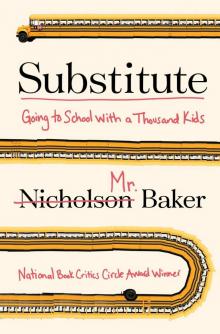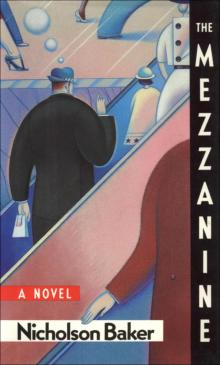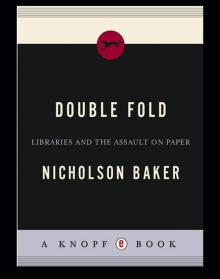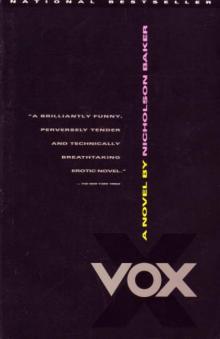- Home
- Nicholson Baker
Substitute
Substitute Read online
ALSO BY NICHOLSON BAKER
Fiction
Traveling Sprinkler
House of Holes
The Anthologist
Checkpoint
A Box of Matches
The Everlasting Story of Nory
The Fermata
Vox
Room Temperature
The Mezzanine
Nonfiction
The Way the World Works
Human Smoke
Double Fold
The Size of Thoughts
U and I
An imprint of Penguin Random House LLC
375 Hudson Street
New York, New York 10014
Copyright © 2016 by Nicholson Baker
Penguin supports copyright. Copyright fuels creativity, encourages diverse voices, promotes free speech, and creates a vibrant culture. Thank you for buying an authorized edition of this book and for complying with copyright laws by not reproducing, scanning, or distributing any part of it in any form without permission. You are supporting writers and allowing Penguin to continue to publish books for every reader.
Blue Rider Press is a registered trademark and its colophon is a trademark of Penguin Random House LLC
Excerpts from Hop on Pop by Dr. Seuss, copyright © by Dr. Seuss Enterprises, L.P., 1963, renewed 1991. Used by permission of Random House Children’s Books, a division of Penguin Random House LLC.
All rights reserved.
eBook ISBN 9780399576379
Penguin is committed to publishing works of quality and integrity.
In that spirit, we are proud to offer this book to our readers;
however, the story, the experiences, and the words
are the author’s alone.
Some names have been changed.
Version_1
To my wife Margaret, my daughter Alice, and my son Elias
CONTENTS
ALSO BY NICHOLSON BAKER
TITLE PAGE
COPYRIGHT
DEDICATION
PREFACE
LEARNING TARGETS
DAY ONE: Small but Hostile
DAY TWO: Mystery Picture
DAY THREE: I Suck at Everything
DAY FOUR: Your Brain Looks Infected
DAY FIVE: Toast
DAY SIX: Out Comes the Eyeball
DAY SEVEN: What the Hell Was That?
DAY EIGHT: He’s Just a Hairy Person
DAY NINE: I Can Write, but I Don’t Write
DAY TEN: Don’t Kill Penguins Cause Other Friends Get Sad
DAY ELEVEN: She Stole My Grape
DAY TWELVE: I Don’t Judge
DAY THIRTEEN: There’s Nothing Exciting or Fun Happening Today
DAY FOURTEEN: When You Close Your Eyes and Think of Peace, What Do You See?
DAY FIFTEEN: But We Didn’t Do Anything
DAY SIXTEEN: Silent Ball
DAY SEVENTEEN: Non-Negotiables
DAY EIGHTEEN: The Man Who Needs It Doesn’t Know It
DAY NINETEEN: Simple Machines
DAY TWENTY: Stink Blob to the Rescue
DAY TWENTY-ONE: Keep Your Dear Teacher Happy
DAY TWENTY-TWO: He Particularly Doesn’t Like This Particular Spot
DAY TWENTY-THREE: How Do You Spell Juicy?
DAY TWENTY-FOUR: Hamburger Writing
DAY TWENTY-FIVE: High on Summertime
DAY TWENTY-SIX: I Kind of Break My Own Spirit Sometimes
DAY TWENTY-SEVEN: That’s Just the Way School Is
DAY TWENTY-EIGHT: Plutonic Love
ABOUT THE AUTHOR
PREFACE
THIS BOOK IS a moment-by-moment account of the twenty-eight days I spent as the lowest-ranking participant in American education: a substitute teacher. I taught all ages, from kindergartners to twelfth-graders, and all required subjects—reading, writing, math, social studies, and science—plus a few electives here and there, like metal tech. I taught honors students and students in special ed classes—about a thousand children in all. I didn’t have a teaching certificate, and I’d never taught in a primary or secondary school, but that didn’t matter—all you need is a high school diploma, a clean criminal record, and a willingness to tolerate your own ineptitude.
I sought out the teaching job because I wanted to know what life in classrooms was really like. There are many books of educational advice, of theory, of hagiography, of gloomy prognosis—what’s missing is a lived-through sense of how busy and complicated and weird and long every school day is; how many ups and downs there are, and how exhausting—and sometimes entertaining—school is, for students and teachers both. Forget curriculum, forget the parts of speech and the noble gases, the nature of prime numbers and the components of an argumentative essay: for many kids, going to school is simply about finding a way to get through six and a half hours of compulsory deskbound fluorescence without wigging out and incurring punishment. In these pages I’ve tried to convey, without exaggeration, the noisy, distracted, crazy-making reality of one fairly typical, not-terribly-poor-but-hardly-rich school district. I’m grateful to all the students who put up with my own fumbling attempts at doing my job, and to Sarah Hochman and David Rosenthal, of Blue Rider Press, who gave me the go-ahead to write this book. My wife Margaret, and my children Alice and Elias, to whom I lovingly dedicate this book, helped all the way through.
Before we get started, though, I should probably say something about my own schooling. I went to kindergarten at a private school in Rochester, New York—my mother paid for my tuition by painting circular murals of pelicans and polar bears that hung on the wall of the inner courtyard where we had lunch. For first, second, third, and fourth grade, I went to Martin B. Anderson School Number 1 in Rochester, where I had no homework, except once or twice a semester when we had to write a report. Once I saw a boy squash a praying mantis with his sneaker, a horrible sight, and once I saw another boy slammed into a wall by a teacher during a game of dodgeball. In third grade we learned cursive, and the teacher, Mrs. Newcomb, who disliked me because of my Beatles haircut, told me that I was going to injure my eyesight by reading an old edition of Twenty Thousand Leagues Under the Sea, set in tiny type.
In fifth grade, in 1967, I took part in one of the earliest experiments in voluntary integration: I got on a bus and rode, for an hour, from our middle-class neighborhood in Rochester to Clara Barton School Number 2, in what survived of the poor neighborhoods downtown after the bulldozing erasure of urban renewal. Number 2 was a brand-new school, and I was part of a small white minority. The work was not difficult—and there was an art class where I made a cast of my hand and threw clay pots—and I did practically no homework. I got beaten up once by some older kids, but not badly: that was my only adventure. For seventh grade I went to Number 23 School and was taught by a dashing man who loved basketball. I did nothing in seventh grade except eat Hostess Ho Hos and think about ten-speed bicycles and speed skates. No, not nothing: I completed one five-page report called “The Legs and Feet,” with diagrams of bones and muscles, when we were assigned to write about transportation in New York State. Eighth grade happened in a special wing of Monroe High School, where the homework was minimal and bathrooms were scary and we had to swim naked in gym class, a hideous experience.
High school was, again, permissive and free of homework and other indications of “rigor”: I went to a brand-new experimental public school called the School Without Walls, where I played music and took whatever classes I wanted and watched a lot of sitcoms on TV. While at School Without Walls I also audited courses at the University of Rochester—two literature cl
asses, a history class, and a music theory class at the Eastman School of Music. I graduated a year early and typed my own transcript. And then I went to college—first at the Eastman School, and then at Haverford College, where I learned how to write and worked hard. That’s the entirety of my formal education.
Now for my time as a teacher.
LEARNING TARGETS
IN JANUARY OF 2014, Regional School Unit 66—everyone just called it RSU66—offered an adult-education class at Lasswell High School in Lasswell, Maine, about fifty miles from where I live. It met one evening a week for four weeks. The class was called Substitute Teacher Training. I paid the thirty-four-dollar fee and signed up.
We met in a big white room on a frozen Tuesday night in February. There were eight students sitting at circular tables—a potter, a former seller of artists’ supplies, a former nanny, an elementary school teacher recently moved from Boston, a student from the University of New Hampshire, the wife of a firefighter, a recent high school graduate who wore a brown knit cap, and me. Our teacher, Shelly, passed out a packet of information and said she was going to help us build tools and strategies for our substitute-teaching toolbox. (Her name wasn’t actually Shelly—I’ve changed most names, places, and physical descriptions in this book so as not to cause embarrassment or grief.) Everyone who completed the class would receive a certificate and would get paid an extra five dollars per day of substituting, she said. So we would be making seventy dollars a day.
“I don’t like to play sage on the stage,” Shelly said, but she had a lot to talk about. She’d been an elementary school teacher before moving up to administration, and she spoke in a pleasant, cheerful, sixth-grade-teacher voice. She wore black flare pants and a gray knit sweater. The key to RSU66’s approach was “voice and choice,” she told us. Students should have a voice in the classroom, and they should and in fact did help to formulate each classroom’s unique code of cooperation, using a technique called “power voting,” which Shelly taught us. It involved brainstorming in groups of two and the use of many yellow stickers. For the power voting exercise I was paired with the former nanny. She’d recently had open heart surgery: when she sneezed, she winced.
Every classroom’s code of cooperation was posted on the wall, Shelly said, and every class also had a series of “learning targets,” which conformed to the Common Core standards recently adopted by many states around the country. For example, one ninth-grade learning target for social studies was: “Understands how the interaction of various religions has impacted history.” But because students learn at different rates, and because RSU66’s test scores, especially in reading, had been coming in too low, the district had adopted a performance-based approach, in which each child could theoretically master different targets at different times. The mission of RSU66, Shelly told us, was as follows: “To lead, to engage, and to inspire a community of respectful learners.”
The district needed substitute teachers who genuinely liked kids, Shelly said. “I’ve had to dismiss a sub for throwing a box of tissues at a child. Not okay.” She showed us some videos of the newly reformed elementary reading classes at RSU66, which used proven instructional techniques called the “daily five” and the CAFE method. CAFE stood for “Comprehension, Accuracy, Fluency, and Expanded vocabulary,” but one of the district’s teachers had rearranged it so that it spelled FACE, starting with Fluency. An appealing little girl in the video said the new approach was working for her: “I’ve never been much good of a reader or speller, and this kind of helps me. If I can understand reading, I can understand words and spelling more better.”
Then Shelly taught us how to play a math game called What’s My Number? She’d used it on her sixth-graders with great success. Each of us got an index card. One of the would-be substitutes read her card: “I have twenty-four—who has two more?”
There was a silence. I stared down stupidly at my card, which said 26. Suddenly my heart thumped. “I do, I think,” I said. “I have twenty-six. Who has ten less?”
Somebody said, “I do. I have sixteen—who has half of me?”
Another pause. An answer. A question. We went around the room doing mental computations, not always correctly. “Anyway, just something fun,” said Shelly. She told us we might consider assembling a little canvas bag of puzzles, games, and “motor breaks,” for those moments when a classroom was getting fidgety, especially toward the end of the day. “Any questions?”
The man who used to sell artists’ supplies asked what time we might get a call from the sub caller.
“If it’s middle school or high school, I think she starts calling as early as five or five-thirty in the morning,” Shelly said. “Not only does she have to fill every spot, she has to give you time to travel.” High school and middle school officially began at seven-thirty. “You don’t want to arrive any later than seven o’clock.” Elementary school began later, at nine a.m., so we’d need to be there at eight-thirty. There was a need for subs at all grade levels.
She also told us about the mandatory fingerprinting and criminal background check, which cost fifty dollars. We’d need to make an online appointment to be fingerprinted.
At nine o’clock, class was done. “I left for work at six-thirty this morning, so I’ll be glad to get home,” Shelly said. “Have a good night, everyone.” We thanked her and walked out into the icy, gritty wasteland of the parking lot and drove home.
—
THE RECEPTIONIST at RSU66’s fingerprinting office said, “The little boys’ room is just down the hall on your left. I’d like you to get your hands nice and soapy and clean, and then take a chair, and Sharon will be with you shortly.”
My fingerprinting session went poorly. Sharon, the fingerprint technician, held my hand and helped me roll my fingers over the little glass scanning window, but each time, after a moment of computation, an image of my fingertip would appear on her computer screen with little mauve areas superimposed on it that indicated biometric inadequacies, and then a rectangle would pop up saying REJECTED. After many tries and much sighing Sharon overrode the system and sent my flawed scans off to the identity service, IdentoGO, run by MorphoTrust USA, a subsidiary of Safran, which is a French manufacturer of aerospace components, bombs, and drones. “We’ll see what they say,” she said. Some people just didn’t fingerprint well, apparently. “I had one woman in here, she was a pianist, and she’d worn her fingerprints away. Do you do a lot of typing?” I said I typed all the time. “That’s probably it,” she said.
—
ON THE SECOND TUESDAY NIGHT, I told Roy, the former seller of artists’ supplies, that the idea of being in front of a class of kids frankly scared me.
“They say ex-military make good substitutes,” Roy said. We laughed nervously.
“So, we can get started,” said Shelly.
She introduced two women, Mrs. Norris, principal of Wallingford Elementary School—one of four elementary schools in the district—and Mrs. Ecklin, RSU66’s director of special education. Mrs. Ecklin gave us an overview of some relevant vocabulary. Children who were diagnosed as having some sort of disability were given an IEP, or Individualized Education Plan; a list of IEP students in a class was usually to be found in the sub folder, along with any “accommodations” they were entitled to, such as extra help with taking a test. On the Individualized Education Plan were various codes: LD meant learning disability—for instance, dyslexia—ED meant emotional disability, S&L meant speech and language complications, and OHI stood for “Other Health Impairment,” a catchall that included attention deficit disorder, depression, autism, deafness, blindness, and anxiety. “Anxiety is a huge one at the middle school and high school,” Mrs. Ecklin said. “It’s even trickling down to the elementary school.” Kids who’d had cancer treatment were sometimes classed under OHI, because chemotherapy drugs can cause mental problems. “Unfortunately, the law is we have to label them to give them services,” she said.
/>
Mrs. Norris, the principal, said, “Never make the assumption—not that you would—that because a child has an identifying label that somehow is indicative of their intellectual capabilities. I’ll never forget the child who was identified LD with an IQ of 142. When it came to phonemic awareness, he struggled, but when something was read to him, his capacity to understand it and give it back to you was off the charts. Every child should be treated as though he or she was your daughter, your son, your niece, your nephew, your grandchild—with dignity and respect and empathy. They did not leave their home that morning saying to themselves, ‘I’m going to go to school and be as naughty as I can and make the teacher’s life as miserable as I can.’ I’ve been doing this for twenty-nine years. I’ve never met a child who’s had that intent. Now, do things get in the way, and cause them to be quite challenging at times?” She laughed. “Yes! But you have to take a step back, and ask yourself what it is that they’re lugging. Did they have breakfast that morning? Did someone yell at them? Did someone hit them? Did their brother lock them out? As a substitute, you don’t know them and don’t know their history, and you have to give them the benefit of the doubt. You have to assume, whatever it is that they’re doing, whether it’s yelling, screaming, throwing something, calling you a name, that there’s a reason behind it that has very little to do with you. The more compassionate and empathetic you are, and the calmer you are, the more success you’ll have.”
Use humor, not the hammer, Mrs. Norris said. “Humor will defuse and be your friend. And if they say something funny—sometimes they’ll say stuff and it’s genuinely funny and it’s not hurting anybody, it’s just funny—it’s okay to say, ‘Hah, that was a good one.’” Then move on. But don’t let chaos spread, she said. You can do a lot with a raised eyebrow, a warning look. “That’s the biggest mistake subs make—they give kids too much rope.”
Mrs. Ecklin said, “I’ve been in special ed for thirty years and it’s the really naughty ones I really like.”

 House of Holes
House of Holes Checkpoint
Checkpoint U and I
U and I The Fermata
The Fermata Substitute
Substitute The Size of Thoughts
The Size of Thoughts Mezzanine
Mezzanine The Anthologist
The Anthologist Traveling Sprinkler
Traveling Sprinkler Double Fold
Double Fold The Everlasting Story of Nory
The Everlasting Story of Nory Vox
Vox Vintage Baker
Vintage Baker A Box of Matches
A Box of Matches